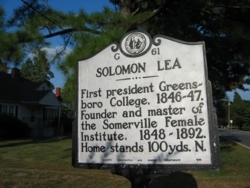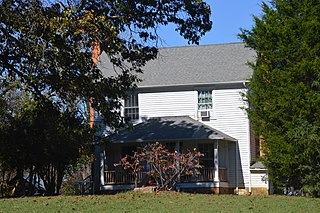
Green Level is an unincorporated community near the town of Cary in southwestern Wake County, North Carolina, United States. It was founded around 1800, and is one of the oldest surviving crossroads communities in the Raleigh area.

Leasburg is a former town and the former county seat of Caswell County, North Carolina. The community has a partial presence in Person County. The population was 1,662 at the 2010 census. It was named in honor of longtime resident William Lea and is located along US 158 and NC 119 near Hyco Lake. Leasburg is also the name of a Caswell County township.

Semora is an unincorporated community in Caswell County, North Carolina. It lies just northwest of Hyco Lake and has some presence in Person County. Semora is home to one of the oldest churches in North Carolina, the Red House Presbyterian Church.

The New Hill Historic District is a national historic district located at New Hill, North Carolina, an unincorporated community in southwestern Wake County. The district encompasses the commercial and residential center and includes 2,820 acres (11.4 km2), 59 buildings, and one structure. The district developed between about 1860 and 1950, and includes notable examples of Colonial Revival and Tudor Revival style architecture. Notable buildings include the W. T. Roundy commercial complex, C.J. Bright's general merchandise store or New Hill Emporium, W. T. Roundy House, Duncan Lashley House, John Bright House, New Hill Baptist Church, Glass-Gardner House, and several farm complexes.

Roxboro Male Academy and Methodist Parsonage is a historic school and church parsonage located at 315 N. Main Street in Roxboro, Person County, North Carolina. The original main block was built between 1840 and 1854, as a two-story, single-pile, frame building with Greek Revival style design elements. A two-story addition with Italianate style design elements was added in the late-19th century. The house took on some Colonial Revival style design elements with the addition of a front porch and interior changes in that style. It is one of the oldest buildings still standing in the town of Roxboro and served as a Methodist parsonage from 1854 to 1915.

South Union Street Courthouse and Commercial Historic District is a national historic district located at Concord, Cabarrus County, North Carolina. The district encompasses 11 contributing buildings in the central business district of Concord. It primarily includes commercial buildings in popular architectural styles including Italianate, Romanesque Revival, and Second Empire style architecture. Located in the district are the Elks Hall, former Town Hall, G. W. Patterson Wholesale Grocery, Pythian Building, Watch Repair Shop, and former Cabarrus Savings Bank (1923-1924). Also in the district is the separately listed former Cabarrus County Courthouse.

Downtown Gastonia Historic District is a national historic district located at Gastonia, Gaston County, North Carolina. It encompasses 77 contributing buildings and 1 contributing object in the central business district of Gastonia. The commercial, civic, institutional, and multi-unit residential buildings were built between the 1890s and 1954, and include notable examples of Colonial Revival and Classical Revival architecture. Located in the district are the separately listed former Gaston County Courthouse, First National Bank Building, Third National Bank Building, and Robinson-Gardner Building. Other notable buildings include the U.S. Post Office (1935), York Medical Building (1938), Kress Department Store, Leibowitz Department Store, Ideal Moving Picture Theater, City Hall, Kirby Building (1922), First Baptist Church (1922), Gaston County War Memorial Hall (1928), and the (former) Gaston County Public Library (1930).

Main Street Historic District is a national historic district located at Hendersonville, Henderson County, North Carolina. The district encompasses 65 contributing buildings in the central business district of Hendersonville. The commercial and governmental buildings include notable examples of Classical Revival architecture. Located in the district is the separately listed Henderson County Courthouse. Other notable buildings include the Huggins Building, Cole Bank Building, Justus Pharmacy, Davis Store block (1900), The Federal Building (1914), Maxwell Store Building, Pace's Market, J. C. Penney Building (1939), and Lampley Motors.

Lincolnton Commercial Historic District is a national historic district located at Lincolnton, Lincoln County, North Carolina. It encompasses 62 contributing buildings and 2 contributing objects in the central business district of Lincolnton. It includes a variety of commercial, institutional, and industrial buildings dating between about 1900 and 1955. Located in the district are the separately listed Classical Revival style Lincoln County Courthouse and First United Methodist Church. Other notable buildings include the Frank Beal House, Karl L. Lawing House, Reinhardt Building, Carolina First National Bank, Central Candy and Cigar Company, Jonas Building, Wampum Department Stores, Rhodes and Corriher Company building, and Coca-Cola Bottling Company building.

Williamston Commercial Historic District is a national historic district located at Williamston, Martin County, North Carolina. The district encompasses 31 contributing buildings in the central business district of Williamston. They include notable examples of Greek Revival, Colonial Revival, and Romanesque architecture in buildings dated from the mid-19th century through the 1920s. Located in the district is the separately listed Martin County Courthouse. Other notable buildings include the Docton W. Bagley Building, (former) People's Bank (1917), Watts Theatre, the Tar Heel Apartments (1921), the Flatiron Building, and the United States Post Office (1938). The post office contains a mural, First Flight of the Wright Brothers at Kitty Hawk, by Philip von Saltza, painted in 1940 as part of the Works Project Administration's mural project.

Person County Courthouse is a historic courthouse building located at Roxboro, Person County, North Carolina. It was designed in 1930 by architect Charles C. Hartmann, and is a four-story, rectangular, Classical Revival style tan brick building. The front facade features paired pilasters with flattened and stylized Corinthian order caps.

Holloway-Jones-Day House, also known as the Day House, is a historic home located near Roxboro, Person County, North Carolina. It was built about 1840, and is a two-story, Federal style frame farmhouse. A rear ell and hip roofed front porch with Italianate style decorative elements were added in the mid-19th century. It has brick gable end chimneys, front and rear transoms, a hall-parlor plan and a fieldstone cellar.

House on Wagstaff Farm is a historic home located near Roxboro, Person County, North Carolina. It is dated to the early-19th century, and is a 1 1/2-story, single-pile, frame dwelling. The interior has a hall-parlor plan and transitional Georgian / Federal style detailing. It has a side gable roof and stone and brick gable end chimneys.

James A. and Laura Thompson Long House is a historic home located at Roxboro, Person County, North Carolina. It was built in 1896, and is a two-story, rectangular, Queen Anne style frame dwelling with a rear ell and enclosed rear porch. It features round towers with conical roofs at the front corners, a one-story wraparound porch with Doric order columns, and a hipped slate roof with dormers. The house was subdivided into apartments in the 1940s. Its builder, J. A. Long (1841–1915), is considered the "founder of modern Roxboro."

Merritt-Winstead House is a historic home located near Roxboro, Person County, North Carolina. It was built in 1915, as a 1 1/2-story, transitional Queen Anne / Colonial Revival style frame dwelling. It was enlarged in 1934 to a two-story, three bay, Colonial Revival dwelling veneered in brick with a one-story, wrap-around American Craftsman-style front porch. A one-story vestibule was added to the front facade about 1950. Also on the property are a contributing carport, garage, tennis court, swimming pool complex, well house, two grape arbors, Bill Joe's Play Doctor's Office, retaining walls, storage building, barbeque grill, and rock walls and a boxwood garden.

Roxboro Cotton Mill is a historic cotton mill complex located at Roxboro, Person County, North Carolina. It was built in 1899, and is a two-story, banked, textile mill with Italianate-style influence and slow-burning heavy timber frame construction. An addition to the original mill building was built in 1924, and together they measure approximately 525 feet long. The building housed the spinning and carding operations. The mill remained in operation until 1999.

Main Street Historic District is a national historic district located at Rutherfordton, Rutherford County, North Carolina. It encompasses 43 contributing buildings and 1 contributing object in the central business district of Rutherfordton. The district developed from about 1898 to 1945, and includes notable examples of Classical Revival and Colonial Revival style architecture. Located in the district is the separately listed Rutherford County Courthouse designed by Louis H. Asbury (1877-1975). Other notable contributing buildings include the U.S. Post Office (1931), the Norris Public Library (1933), (former) Rutherford County Jail, Commercial National Bank, Keeter Hardware Company Building, Geer Commercial Building, Southern Hotel Company Building, Geer-Warlick Motor Company Building, and City Hall (1925) designed by Milburn, Heister & Company.

Clinton Commercial Historic District is a national historic district located at Clinton, Sampson County, North Carolina. The district encompasses 67 contributing buildings and 4 contributing objects in the central business district of Clinton. It developed between about 1902 and 1951, and includes notable examples of Colonial Revival, Tudor Revival, and Classical Revival architecture. Located in the district are the separately listed Bethune-Powell Buildings, Clinton Depot, and Johnson Building. Other notable buildings include the Sampson County Courthouse, Bank of Sampson (1902), Henry Vann Building (1924), William's Building, DuBose Building (1938), and U. S. Post Office (1936) designed by the Office of the Supervising Architect under Louis A. Simon.






















